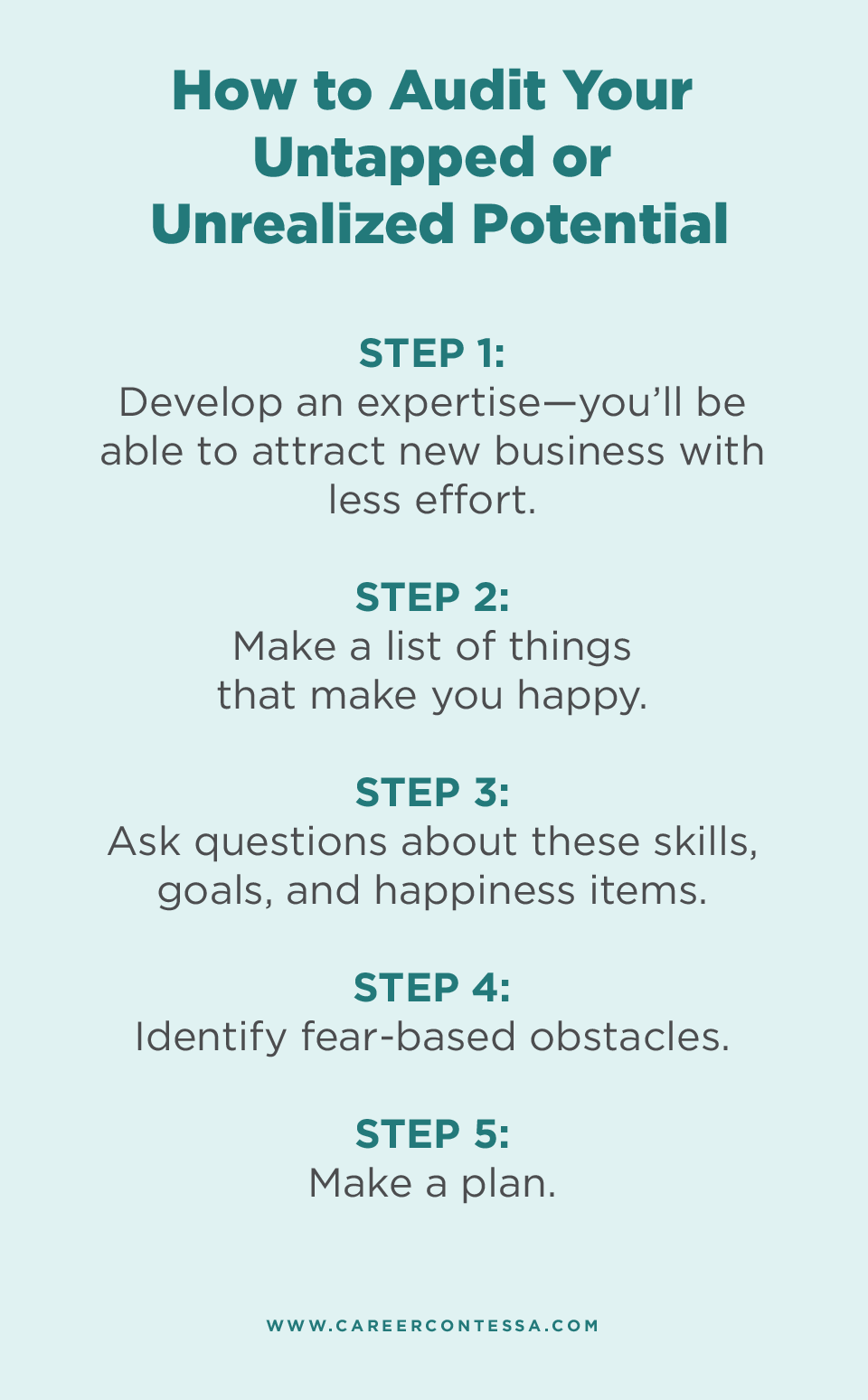We're not here to stress you out. But we are here to SHAIM you.
As we navigate through months of quarantine and head into the spring, we have probably done a ton of soul-searching, Instagram scrolling,
Netflix-watching, and surviving. As the days begin to blend together, as the lines between work and home blur more and more, and as many women readjust their lives to simply make it through the day at hand, it can be tough (or impossible) to take time to measure where your potential might be versus where you are.
We often speak about upskilling at work, training ourselves to open up to
difficult conversations, honing
our skills, and more tactical career advice. But, underneath your career, your job title, and your future aspirations is where
who you are lives.
So, we scoured some pretty woo-woo sites, we read up on
Quora (which was so helpful) and we came up with this 5-step method to check in with yourself, where you are, and whether your potential checkpoints have moved.
A note before reading: There's a lot of push and pull, especially mid-quarantine, about whether we're "making the most of it." Some of us are simply trying to survive—and that's
more than enough. If you relate to that, maybe
dive into some self-care items instead.
Bookmark this for a later point. Take care of you.
How to Audit Your Untapped or Unrealized Potential
Let's bring it back to grade school.
Do you remember learning to spell or read? Once you mastered these skills, your world opened up. All of a sudden, when your parents spelled out "N-A-P" or "V-E-G-G-I-E-S" you knew the kind of stunts they were trying to pull.
When you learn vast new skills, your world opens up. That's what this potential method is about. It's about checking in with yourself to see where you are. From there, you can use it to
add on to your life, to broaden your horizons, and (since we are, after all, a career site) advance your career.
Here is our 5-step SHAIM method to tap into your potential. What does SHAIM stand for?
- Skills (Past, Present + Future)
- Happiness
- Asking Questions
- Identifying Fear Obstacles
- Making Plans
S: Make a List of Your Best Skills + A List of Feats You’d Like to Achieve
First things first: let's see where your skills currently lie. For your first list, choose five things that you're really good at. It can be anything, seriously. If you're good at bird-calling, list that—it's relevant because it's part of who you are.
If it's a struggle to name five things, we still want you to list five things (sorry, not sorry). Especially if you err on the side of modesty like many women, it can feel near-impossible to list more than two.
Is it time to phone a friend? If you're struggling to list more skills and talents, phone a friend. It can be your best friend, your mom, or even a significant other. Ask them what they think you're good at. You'll probably be surprised (and flattered) at the answers. And now? Your list is filled out. Here's what it might look like:
- I am a great speller
- I am a strong swimmer
- I am a curious person
- I am an excellent listener
- I think before I act
Next, yes, it's another list! We love lists. Create a list of skills you'd like to learn or feats you'd like to achieve. This list can be as long (or short) as you want it to be. However, once you've created the list, prioritize the three "biggest feats" you'd want to go after. It could look something like this:
- Get promoted to a management role
- Learn how to build my own website from scratch
- Wallpaper the bathroom by myself
- Run a half marathon
They're all pretty different and they can feed into different areas of your life. If your focus is career-based, all three might have to do with your career. If your focus is on your physical health, all three goals might be in implementing healthy habits.
H: Make a List of Things That Make You Happy
In researching potential, we arrived at the conclusion that your best potential is going to reside at the cross-section of expertise and happiness. So, make a list of things that make you happy. It might look something like this:
- Reading + journaling
- Listening to scientific podcasts
- Giving + receiving positive feedback at work
- Spending time with my best friend
- Baking new things
- Exercising
Unlike the prior lists, make this one as long as humanly possible. Also, be truthful. If taking an entire Sunday to watch Golden Girls reruns in your bed makes you happy, that's it. Things that make you happy also reduce your stress, inspire creativity, and generally have nice effects on your entire being. We're pretty sure science will back us up on this one. Among many other things, happiness has been shown to reduce the risk of heart disease by up to
22 percent.
Once you've completed step two, you have a Happy List to turn to whenever life gets...challenging. The things that make you happy are crucial in your own self-care. Refer to this list often.
A: Ask Questions About These Skills, Goals, and Happiness Items.
So, now you have three lists. You have your best skills, skills + feats you'd like to achieve, and your happiness items.
Before we dive into this step, we want to talk more about potential. Bringing it back again to school, you may or may not have received a report card that said, "Geena is great, but I fear she isn't living up to her potential." Then, your parents got mad at you, you got mad at your teacher, and nobody learned anything.
Discovering your true potential is—quite frankly—nobody's business but your own. That doesn't mean that an outsider can't recognize your unique strengths and opportunities for your growth. It just means that it's really up to you to put a serious thinking cap on. Enter creativity.
Get creative. So, you have your three lists. Now, merge them. You can make a Venn Diagram in order to see where they intersect or you can take the television detective route and create a
Crazy Wall. Whichever method works for you, do your best to connect your existing skills, your desired skills, and your happiness items. Your big reveal might come when you creatively fuse the three. Let's take an example from above.
- Something I'm good at: I am an excellent listener
- Something I want to learn or achieve: I want to get promoted to a management role
- Something that makes me happy: Giving + receiving positive feedback at work
We chose a career-driven option here, but you might be surprised how your three lists mesh pretty effortlessly. So, now we have a goal, a happiness item, and a pre-existing skill set that is pretty freaking important when it comes to
being a leader. So, you're ready to go out and get it, right? One more thing.
I: Identify Fear-Based Obstacles
Ah, yes! Fear is the ultimate stop-you-in-your-tracks source of frustration.
When you pause for fear, other nuisances pop up and get to chattering. Your
negative self-speak and
impostor syndrome thrive in fear. So, as you're sifting through your potential items, make a space for fear. Addressing it head-on allows you to explore ways to jump over it.
Let's go back to our main example. With our skills, our goal, and our happiness item, we have basically found a pretty solid track to a leadership role. What's stopping you now? Well, probably a million negative thoughts. Isn't it funny how it can be so difficult to make a list of things we're good at, but when it comes to fear-based thoughts, they just create themselves?
Here are some possible fear-based thoughts in regards to going after our leadership potential—and how you might nip it in the bud right away.
- There's no position at my current company. That doesn't mean there won't be in the future. Maybe I should have a discussion with my manager to explore any future options.
- I don't really have the experience. Ok, I probably do. I should conduct an audit of successful projects, clients I've managed, and other indicators of pre-management experience.
- My boss will be offended if I express interest. Actually, my boss will probably be flattered? If I frame a future goal with my boss, she will likely be receptive to my ambition. I can also use this opportunity to discuss her best management lessons and advice.
M: Make a Plan
There's no hard and fast rule about when you need to achieve a goal. To be completely honest, some will take a week, some will take months, and others might be lifelong learning opportunities. However, we think it's important to check in with yourself. At the minimum, using the SHAIM method is a great way to reconnect with your skills, your passions, and your ambition.
So, make a plan. Have difficult conversations with yourself—then bring them to others. After you make your plan, make another plan to check in with yourself. Your dreams, goals, and aspirations are constantly changing. Be cognizant of the what, why, and how. Use the SHAIM method to conduct personal check-ins.
We are always learning and growing. With growth comes more untapped potential.
Get after it!












